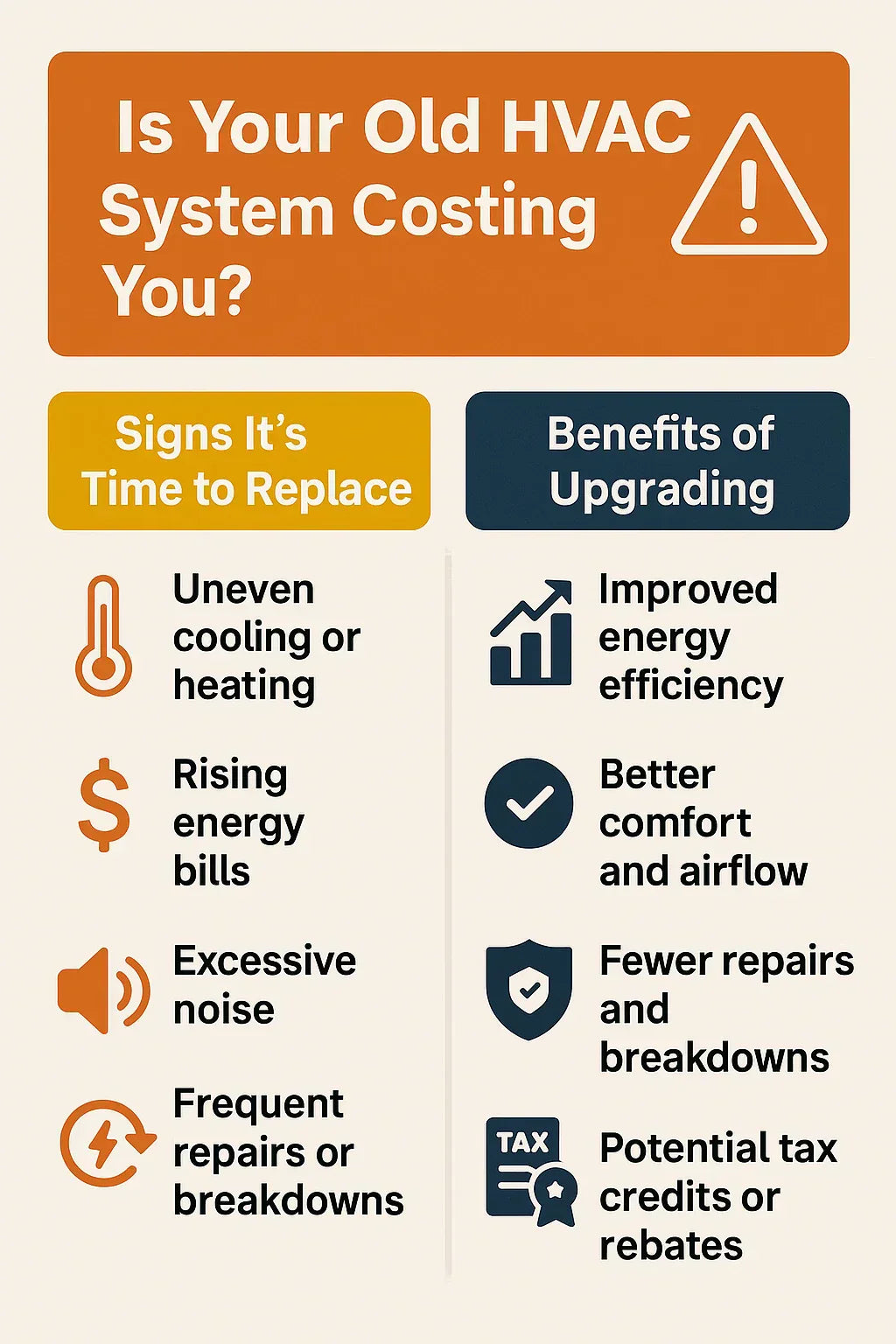🔍 1. Why This Matters for Homeowners Like Mark
HVAC systems are essential, but they don't last forever. Many homeowners like Mark put off upgrading a 10- to 20-year-old system thinking they're saving money—but in reality, those older units are often draining energy, lowering comfort, and costing more long-term.
A modern system like the Goodman 3 Ton 15.2 SEER2 AC + 80,000 BTU Gas Furnace can significantly reduce utility bills, improve comfort, and qualify for rebates.
📉 2. Warning Signs Your HVAC System Is Failing
💸 Higher Energy Bills
-
Are your energy bills climbing year over year?
-
Older systems (10–13 SEER) consume 30–50% more power than a 15.2 SEER2 system.
🌡️ Uneven Heating or Cooling
-
Some rooms stay too hot or cold
-
Could be failing blower motor, poor airflow, or compressor issues
🔁 Short Cycling
-
System turns on/off rapidly
-
Wastes energy, increases wear, and indicates poor sizing or control issues
🔊 Excessive Noise
-
Grinding, rattling, or buzzing may signal motor, capacitor, or fan blade failure
🔧 Frequent Repairs
-
Multiple repairs in 12–24 months, especially major parts (compressor, heat exchanger)?
-
Time to assess cost of ownership vs. replacement
🔥 Safety Issues (for Gas Furnaces)
-
Cracked heat exchanger = carbon monoxide risk
-
Yellow flame = incomplete combustion
⏳ 3. System Age: What Happens After 10–15 Years
| System Age | Typical Efficiency Loss | Risk of Major Repairs |
|---|---|---|
| 5 years | 5–10% | Low |
| 10 years | 15–25% | Medium |
| 15+ years | 30–40% | High (heat exchanger, compressor, TXV) |
Many older AC units are rated 10 SEER or lower. New minimum in most states is now 14.3 SEER2 — a big jump in energy savings.
⚙️ 4. Efficiency Matters: SEER2 and AFUE Breakdown
Older System
-
10 SEER AC
-
70–75% AFUE gas furnace
New Goodman System
-
15.2 SEER2 AC (~14.5 SEER equivalent)
-
80% AFUE furnace
Savings Example:
-
Replacing 10 SEER with 15.2 SEER2 = ~35% cooling savings
-
Replacing 70% AFUE with 80% = ~14% heating fuel savings
💰 5. Hidden Costs of Keeping an Old System
Energy Waste
-
Higher bills = slow financial bleed
Poor Indoor Air Quality
-
Dust, humidity, allergens increase as blower and ducts degrade
Comfort Loss
-
Takes longer to heat or cool
-
Can’t maintain setpoint
Home Value
-
New buyers view aging HVAC as a liability
📊 6. Cost of Ownership vs. Replacement
Formula:
Annual Operating Cost = (kWh used × local electric rate) + (therms × gas rate) + average maintenance
Compare:
-
Old system: $2,400/year (energy + repairs)
-
New Goodman system: $1,500/year
In just 3–5 years, the Goodman combo could pay for itself.
✅ 7. When to Pull the Trigger
Upgrade if:
-
System is 15+ years old
-
SEER rating is under 13 or AFUE under 75%
-
Repairs > $800/year
-
Comfort and air quality are declining
-
You're planning to stay in your home 3+ years
🎁 8. Upgrade Incentives in 2025
Federal Tax Credits (25C)
-
Up to $600 credit for high-efficiency central AC or gas furnace
-
Goodman 15.2 SEER2 + 80% AFUE may qualify depending on region
Local Utility Rebates
-
Rebates from $150–$1,000 for ENERGY STAR systems
Manufacturer Rebates
-
Goodman occasionally offers seasonal discounts via dealers
📋 9. Questions Mark Should Ask Before Replacing
-
How much longer is my current system expected to last?
-
What’s the SEER and AFUE of my existing equipment?
-
What will I save annually with a new Goodman system?
-
Does my home need ductwork improvements too?
-
What rebates or tax incentives apply to my ZIP code?
🔗 10. Verified Resources
🧭 Final Advice for Mark
“If your HVAC system is over 15 years old and you're paying more for comfort you’re no longer getting, it’s probably time to upgrade.”
In the next topic we will know more about: What Size HVAC System Do I Really Need? How to Match Tonnage and BTUs to Your Home







